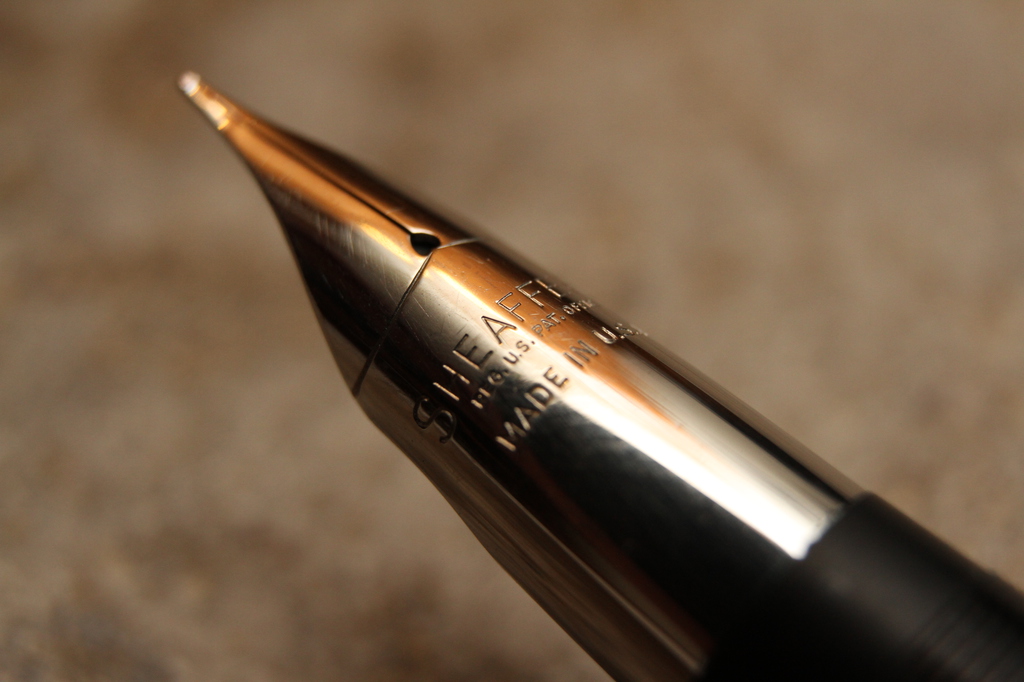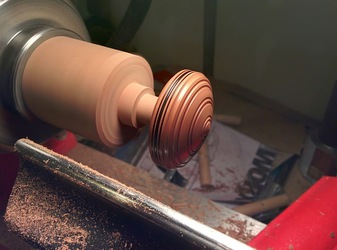Sign In
CloseThis is the "Triumph" point of the first Sheaffer Snorkel I restored. A rather unique bird in the world of pens, the Triumph was the first nib to be a full wrap-around design, instead of just covering the top of the feed. They write very, very smoothly and are a favourite of mine for daily use.
Submission Information
- Views:
- 393
- Comments:
- 9
- Favorites:
- 0
- Rating:
- General
- Category:
- Visual / Photography
Comments
-
-

Dang, very nice! I've not gone as far back as using nibs in anything aside from a standard Speedball dip-pen holder (I use that for testing inks and extra-fine lining), but that sounds rather awesome! You should shoot some pictures of your quill setup at some point. :)
In this case, I purchased the pen in "unrestored good" condition, on Ebay. I was rather insane to even try this one for my first restore, it is a fairly rare "early production" gold-tube version, which is something that really should have gone to a professional given the rarity. Fortunately, I was able to carry it out without significant trouble. There was no real damage on this one, aside from the standard ravages of time. Natural latex rubber does not stand up to time well, and tends to harden to approximately the same flexibility as glass over the time spans involved here.
My restoration was a fairly simple one, the Snorkel is a complex mechanism, but fairly simple in concept. I disassembled the sac protector assembly, disassembled the touchdown tube assembly, and removed the nib holder from the section. The nib holder (with nib) and touchdown tube both went into the ultrasonic cleaner with a 1/10 ammonia solution for a five-minute cycle, while I scraped the ossified sac out of the sac protector and removed the remaining bits from the sac nipple, then ran the same 1/10 solution through the snorkel tube until it ran clear, and rinsed it with clean water. Then I used some Flitz to buff the cap, body, and Touchdown cap up again nicely to a shine. I cut the new sac to length and shellaced it in place, set that aside to dry, and while that was drying, I replaced the touchdown-tube O-ring. Greased that well, re-assembled the touchdown section, then dusted the sac with talc and re-installed the sac protector. Crimping it properly again was a bit challenging, but it worked well in the end. Had to adjust the rails a little bit to get it to move smoothly in the section. Then replaced the point seal, VERY lightly greased that, and re-installed the sac protector assembly and nib holder on the section. After that, just a matter of making sure the spring was cleaned and ran smoothly in the body, and screwing the body back on with a tad bit of section sealant to make sure the air seal was tight.
It sounds a lot harder than it actually is, really. And I only VERY slightly had to adjust the nib, one of the tines was slightly off plane to the other so it was a bit scratchy. Just careful pressure with the tip of a toothpick let me put it back into alignment. Writes very nicely now! :)
What challenges are you running into? :D
-

Okay the word you use for quill-tip is nib, okay. My dictionary is british english, and it doesn't cover rather exotic topics.
Clearly, the only two issues you have with solitary nibs is misalignment of the planes - which I am still working on, trying to get straightend out - and dried ink which sometimes is a pain in the ass.
However, as the nibs are plain steel, you can use rather aggressive solvents with abandon, from window-cleaner to nitro-thinner or paintstripper, with no harm done.
So far I have a bottle of window-cleaner and a botthe of nailvarnish-remover on my desk to clean nibs that accumulated too much dried ink.-

Have you ever tried using ultrasonics? I use an ultrasonic cleaner with either that 1/10 ammonia/water solution, or a solution of a couple drops of dishwashing soap in tank full of clean water. For the shellac in most india inks, a good solvent might be denatured alcohol (aka 'Meths').
Honestly, bare steel dip nibs are intended to be inexpensive and more or less disposable. Unless you have very rare flex nibs or something otherwise uncommon, if they go out of alignment or get sprung, just chuck 'em.
-

I don't use india Inks, but something named "Tusche". Aaaand as I see ,that is called India Ink in US english. Funny. In any case, there are no hardening substances like shellac, but only stuff gumming up over time.
Which doesn't come off in my ultrasonic cleaner. :(Accordingly I guess the stuff I use has a different composition than your india ink.
And as there is no material aside of steel in the nibs, I can drown them over night in "nitro-cellulose combination thinner" and then use a soft cloth to swipe them clean the next morning.
Finally:
Meeehhh, they're friends!
I don't like the thought of junking them if I can realign them with gentle force.-

Ah, possibly the gum arabic in it causing the gumming. Most of my work is with fountain pen inks, so I tend to be only peripherally aware of the properties of inks that are not suitable for such use. :)
The ultrasonic cleaner is a very interesting tool! I use mine for all manor of cleaning, from small tool and firearm parts, through pens and jewelry, and even parts for model aircraft engines.
Keep in mind, also, that metal fatigue will eventually set in, no matter how careful you are. They are a disposable tool, and unfortunately will not last forever.-

Mine's an old DIY job, with a free floating, urethane encapsulate piezo. As such I don't dare using too solvents overly much. Still, it does it's job cleaning PCB's before I start to photo-transfer layouts onto them.
-

Ah, yeah, can see where that could be a bit of a challenge! Mine is a stainless-tub unit, with an externally mounted transducer, so I can use more or less whatever I want in it. It's amazingly handy, isn't it? Never done any PCB etching on my own, although I have assembled a number of kits. I enjoy circuit-board soldering. :)
-

I did this tuff here:
http://www.cubeos.org/scipio/
been AAAGES by now :(
-
-
-
-
-
-
-
-




Link
AriesQuitex
I use both Leonard ( UK ) as well as Brause ( Iserlohn / Germany ) and Heintze & Blanckertz ( Berlin / Frankfurt (Main), Germany ) quilltips.
But I use them with either traditional feathers ( Bussard.. that's... Buzzard? ) or wooden quill-holders.
In how far did you restore it?
What had been damaged?
I have a few issues with one of the Leonard calligraphy quilltips and would like a few suggestions and hints.